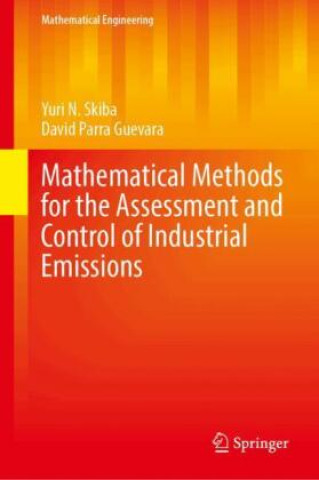
Kód: 45246310
Mathematical methods for the assessment and control of industrial emissions
Autor Yuri Skiba, David Parra-Guevara
Industrial pollution is a serious problem worldwide, both in developed and in developing countries. The rapid growth of the population and significant development of production and transport have led to the release of toxic pollut ... celý popis
- Jazyk:
 Angličtina
Angličtina - Vazba: Pevná
- Počet stran: 392
Nakladatelství: Springer, Berlin, 2024
- Více informací o knize

5043 Kč
Dostupnost:
50 % šance Máme informaci, že by titul mohl být dostupný. Na základě vaší objednávky se ho pokusíme do 6 týdnů zajistit.
Máme informaci, že by titul mohl být dostupný. Na základě vaší objednávky se ho pokusíme do 6 týdnů zajistit.Prohledáme celý svět
Mohlo by se vám také líbit
-

Haunting Adeline
617 Kč -

Berserk Deluxe Volume 1
1033 Kč -

Berserk Deluxe Volume 3
1138 Kč -

LEGO Star Wars Visual Dictionary Updated Edition
534 Kč -

Berserk Deluxe Volume 2
1033 Kč -

Atomic Habits
340 Kč -

White Nights
90 Kč -

Powerless
276 Kč -

Hunting Adeline
633 Kč -

Berserk Deluxe Volume 5
1115 Kč -

Chainsaw Man, Vol. 15
251 Kč -

Harry Potter and the Prisoner of Azkaban (Minalima Edition)
673 Kč -

Iron Flame
353 Kč -

Cry Baby Coloring Book
256 Kč -

JUJUTSU KAISEN V22
241 Kč -

House of Leaves
405 Kč -

Gravity Falls Journal 3
440 Kč -

Dune
200 Kč -

Heaven Official's Blessing: Tian Guan Ci Fu (Novel) Vol. 2
441 Kč -

The 48 Laws of Power
530 Kč -

Twisted Love
259 Kč
Darujte tuto knihu ještě dnes
- Objednejte knihu a zvolte Zaslat jako dárek.
- Obratem obdržíte darovací poukaz na knihu, který můžete ihned předat obdarovanému.
- Knihu zašleme na adresu obdarovaného, o nic se nestaráte.
Informovat o naskladnění knihy
Zadejte do formuláře e-mailovou adresu a jakmile knihu naskladníme, zašleme vám o tom zprávu. Pohlídáme vše za vás.
Více informací o knize Mathematical methods for the assessment and control of industrial emissions
Nákupem získáte 504 bodů
 Anotace knihy
Anotace knihy
Industrial pollution is a serious problem worldwide, both in developed and in developing countries. The rapid growth of the population and significant development of production and transport have led to the release of toxic pollutants that have a negative impact on the environment and human health. The problem of environmental pollution is exacerbated by large industrial complexes whose emissions exceed sanitary standards, as well as accidental or hidden discharges of pollutants. This applies equally to the processes taking place on the continent and in the ocean. Since many gases and aerosols affect the environment in one way or another, the immediate task is to assess the strength and localization of emissions in order to reduce their negative impact.In recent years, the problem of protecting and restoring the environment has become one of the most important tasks of many sciences, the development of which is stimulated by the increasing pace of technological progress inall countries. There are two approaches to reduce emissions and protect the environment in the major industrial regions. The former, so-called technological way deals with "green" technologies that clean air or remove pollutants. The second approach including methods of prevention is of great mathematical interest and is more cost-effective than the application of end-of-pipe treatment technologies. The methods use mathematical models to describe the dispersion of pollutants, and the concentrations of harmful pollutants are regulated by a control of the intensity of emissions from the pollution sources. The advantage of this approach is that it makes it possible to simulate on a computer the concentrations of various primary and secondary pollutants, to determine the sources of excessive pollution of particularly vulnerable areas (residential areas, forests, etc.) and to develop emission control strategies for operating industrial enterprises. Also, this approach allows planning the placement of a new industrial zone and the installation of safety devices in high-risk areas to prevent an accident or unauthorized discharge. This book is intended to introduce the reader to modern mathematical methods for preventing dangerous environmental pollution. It discusses various dispersion models and emission control strategies. The overall goal of all strategies is to limit emissions from pollution sources in order to comply with sanitary standards and prevent risks to human health. Since sanitary standards are usually associated with temporal and spatial averages, the proposed control strategies aim to reduce average concentrations of pollutants to acceptable levels in a particular zone and time interval. An effective control strategy should be applied whenever a short term forecast model predicts a violation of sanitary standards. The focus is on various mathematical aspects related to industrial pollution, including the dispersion and assessment of pollutants, thecontrol of their emissions, and the identification of the basic parameters of unknown sources. Because these problems are interdisciplinary, the reader needs a basic knowledge in differential equations, mathematical modeling, optimization theory, and numerical methods. The attached bibliography contains extensive literature on these environmental issues. To illustrate the basic ideas of mathematical control, we will often use a simple two-dimensional (vertically integrated) model that describes the dispersion of quasi-passive pollutants. Despite this, any control strategy can also be applied to a three-dimensional dispersion model. Various examples of air and marine pollution control are presented in Chapters 5-7. Given its breadth of coverage, the book benefits a wide variety of readers, including researchers, professionals, aspirants, and students.
 Parametry knihy
Parametry knihy
Zařazení knihy Knihy v angličtině Technology, engineering, agriculture Technology: general issues Maths for engineers
5043 Kč
- Plný název: Mathematical methods for the assessment and control of industrial emissions
- Autor: Yuri Skiba, David Parra-Guevara
- Jazyk:
 Angličtina
Angličtina - Vazba: Pevná
- Počet stran: 392
- EAN: 9783031581083
- ID: 45246310
- Nakladatelství: Springer, Berlin
- Rozměry: 235 × 155 mm
- Datum vydání: 11. September 2024
Osobní odběr Praha, Brno a 12903 dalších
Copyright ©2008-24 nejlevnejsi-knihy.cz Všechna práva vyhrazenaSoukromíCookies


 Vrácení do měsíce
Vrácení do měsíce 571 999 099 (8-15.30h)
571 999 099 (8-15.30h)